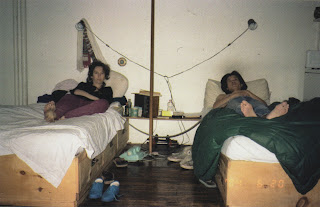Between 1978 and 1985 the Taiwanese-born artist Tehching Hsieh completed five performance pieces in the United States, each of which lasted for precisely one year. Immediately, they were followed by a sixth, spanning thirteen years.
One Year Performance 1978-1979
Sealing himself in solitary confinement in a wooden cage for twelve months, and being wholly reliant on a friend for his food, clothing and refuse.
One Year Performance 1980-1981
Punching a time clock in his studio every hour, on the hour, twenty-four times a day, for 365 days, without a break.
One Year Performance 1981-1982
Living outdoors through all seasons, without ever entering a building or a vehicle.
Art/Life One Year Performance 1983-1984
A collaboration with the performance artist Linda Montano. For a year they remained tied together around the waist with an eight foot rope, and, while the rope obliged them to do everything together, they avoided all intentional bodily contact.
One Year Performance 1985-1986
Living for a year as though art did not exist, neither as a topic of conversation, nor as a subject to read about, nor as a gallery to visit.
Tehching Hsieh 1986-1999
Following these five works, Hsieh commenced a sixth, which would last thirteen years, from 31 December 1986 to 31 December 1999. During this timeframe, Hsieh stated that he would make art, but not show it publicly.
Further details, including additional illustrations, are available at his website,
one-year-performance.com.
These durational works are different from other projects discussed in these pages. Hsieh's programmes are not intended to last for a lifetime: he always stipulates in advance when they will terminate. Nonetheless, Hsieh's art is related to other long-term projects we have been exploring. Like Kawara, his projects rely on unwavering adherence to self-imposed rules. And like Opalka's statement of 1972, Hsieh also issues declarations of intent, carefully laying out his plan. But most importantly, Hsieh's 'lifeworks', as he calls them, explore the relation between art and living, and this is a theme that the work of Absalon, Opalka, and Reinhardt also raises.
In an essay called 'The Meaning of Life' from 1990, Allan Kaprow poses the question 'Is playing at life, life?'
'Life in birds, bees, and volcanoes just is', Kaprow writes. 'But when I think about life it becomes "life". Life is an idea. Whatever that idea might be - playing or suffering or whatnot - it floats, outside of time, in my thoughts. But actually playing at life in any form happens in real time, moment by moment, and is distinctly physical. ...If I think about life under those conditions, it begins to resemble a hair, a crumb, a dead fly. And that's another idea.'
'So lifelike art plays somewhere in and between attention to physical process and attention to interpretation. It is experience, yet it is ungraspable. It requires quotation marks ("lifelike") but sheds them as the un-artist sheds art.'
Kaprow's account of 'lifelike art' as being dual-focused is a helpful way to approach Hsieh's last two projects. Between 1985 and 1986, Hsieh gets on with life, or, as he puts it, 'I just go in life'. But afterwards, this lack of art productivity is presented by the artist as 'art'. In a recent exchange with Adrian Heathfield, he explained that this work was based on one rule, whose purpose was 'distinguishing art and life'. Just 'going in life', just letting time pass: this is the idea. Already it is an interpretation of experience, and so stands outside real time, as a thought, ready and waiting to be called art.
They say art is like the law: both have to be seen to be done. Hsieh's later thirteen year plan, lasting from 1986 to 1999, might have involved the artist making work, but, if he did, it went unseen. It had no witnesses. What we do know is that at a ceremony on New Year's Day 2000 Tehching Hsieh revealed a poster stating that he had kept himself alive.







.jpeg)
.jpeg)


































